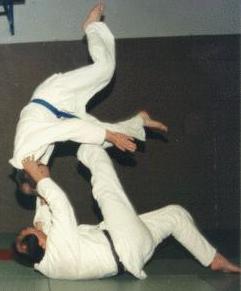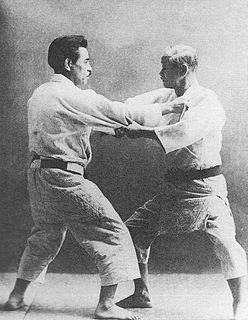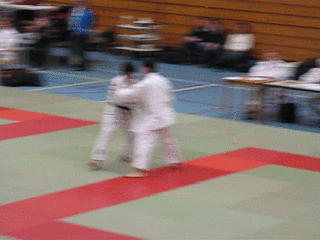
Seoi nage (背負い投げ) is a shoulder throw, one of the traditional forty throws of Judo as developed by Jigoro Kano. It belongs to the first group, Dai Ikkyo, of the traditional throwing list, Gokyo, of Kodokan Judo. It is also part of the current 67 Throws of Kodokan Judo. It is classified as a hand technique, te-waza, and is the second throw performed in the Nage-no-kata.

Kata guruma (肩車) is one of the traditional forty throws of judo as developed by Kano Jigoro. Kata guruma belongs to the third group of the traditional throwing list in the Gokyo no waza of the Kodokan Judo. It is also part of the current 67 Throws of Kodokan Judo. Because the technique is not a sweep nor a trip and requires tori to pull uke into a carry, it is categorized as a hand throwing technique (tewaza).

Hiza guruma (膝車) is one of the original 40 throws of Judo as developed by Kano Jigoro. It belongs to the first group of the traditional throwing list in the Gokyo no waza of the Kodokan Judo. It is also included in the current 67 throws of Kodokan Judo. It is classified as a foot technique (ashiwaza).

The ippon seoi nage is a throw in judo. It is a variant of Seoi nage, and is one of the nineteen accepted techniques in Shinmeisho No Waza of Kodokan Judo. It is classified as a hand throwing technique, or te-waza.

Tsurikomi Goshi (釣込腰), is one of the original 40 throws of Judo as developed by Jigoro Kano. It belongs to the second group, Dai Nikyo, of the traditional throwing list, Gokyo, of Kodokan Judo. It is also part of the current 67 Throws of Kodokan Judo. It is classified as a hip throwing technique, Koshi-Waza. Tsurikomi Goshi is also one of the 20 techniques in Danzan Ryu's Nage No Te list.
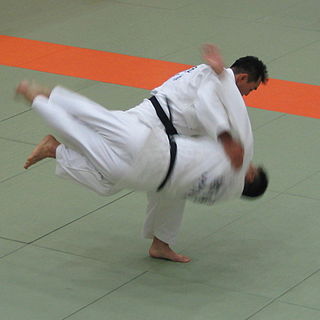
Harai goshi (払腰) is one of the original 40 throws of Judo as developed by Kano Jigoro. It belongs to the second group of the traditional throwing list in the Gokyo no waza of the Kodokan Judo. It is also part of the current 67 Throws of Kodokan Judo, and classified as a hip technique (koshiwaza). Harai goshi is also one of the 20 techniques in Danzan ryu's Nagete list as well as one of the 18 throws in the Kar-do-Jitsu-Ryu martial arts system. English terms include "Sweeping hip throw" and "Hip Sweep".

Hane goshi is a throw in judo. It is one of the original 40 throws of Judo as developed by Jigoro Kano. It belongs to the third group, Sankyo, of the traditional throwing list, Gokyo, of Kodokan Judo. It is also part of the current 67 Throws of Kodokan Judo. It is classified as a hip technique, Koshi-Waza. Hane goshi is also one of the 20 techniques in Danzan Ryu's Nagete list.
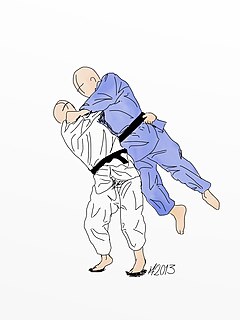
Utsuri Goshi (移腰), or the changing hip throw, is one of the original 40 throws of Judo as developed by Jigoro Kano. It belongs to the fourth group, Yonkyo, of the traditional throwing list, Gokyo-no-Nagewaza, of Kodokan Judo. It is also part of the current 67 Throws of Kodokan Judo. It is classified as a hip technique, Koshi-Waza.

Koshi Guruma (腰車), is one of the original 40 throws of Judo as developed by Jigoro Kano. It belongs to the second group,
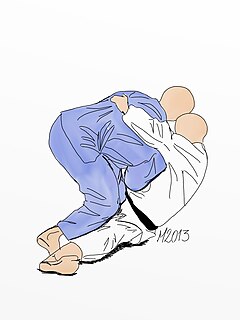
Yoko Otoshi (横落) is one of the original 40 throws of Judo as developed by Jigoro Kano. It belongs to the third group,

Ashi guruma is a throw in judo. It is one of the original 40 throws of Judo as developed by Kano Jigoro. It belongs to the third group of the traditional throwing list in the Gokyo no waza of the Kodokan Judo. It is also included in the current 67 Throws of Kodokan Judo and is classified as a foot technique (ashiwaza).

Harai Tsurikomi Ashi (払釣込足) is one of the original 40 throws of Judo as developed by Jigoro Kano. It belongs to the third group, Sankyo, of the traditional throwing list, Gokyo, of Kodokan Judo. It is also part of the current 67 Throws of Kodokan Judo. It is classified as a foot technique, Ashi-waza.

Sumi Gaeshi (隅返) is one of the original 40 throws of Judo as developed by Jigoro Kano. It belongs to the fourth group,
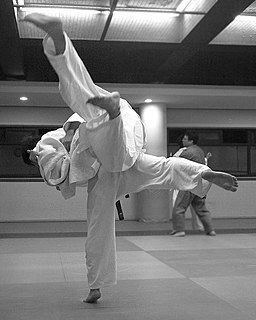
Ō guruma (大車) is one of the original 40 throws of Judo as developed by Kanō Jigorō. It belongs to the fourth group of the traditional throwing list in the Gokyo no waza of the Kodokan Judo. It is also part of the current 67 Throws of Kodokan Judo. It is classified as a foot technique (ashiwaza).

Osoto Guruma (大外車), is one of the original 40 throws of Judo as developed by Jigoro Kano. It belongs to the fifth group,

Uki Waza (浮技), is one of the original 40 throws of Judo as developed by Jigoro Kano. It belongs to the fifth group, Gokyo, of the traditional throwing list, Gokyo, of Kodokan Judo. It is also part of the 67 Throws of Kodokan Judo. It is classified as a side sacrifice technique, Yoko-sutemi.

Yoko Wakare (横分) is one of the original 40 throws of Judo as developed by Jigoro Kano. It belongs to the fifth group,
Hikikomi Gaeshi (引込返), also known as pulling-in counter, is one of the preserved throwing techniques, Habukareta Waza, of judo. It belonged to the fourth group, Yonkyo, of the 1895 Gokyo no Waza lists. It is categorized as a front sacrifice technique, Ma-sutemi.
Kuchiki taoshi (朽木倒) is a single leg takedown in Judo adopted later by the Kodokan into their Shinmeisho No Waza list. It is categorized as a hand technique, Te-waza.

The Canon of Judo is a book that was originally published in 1956, and written by Kodokan 10th dan, Kyuzo Mifune (1883-1965). The book covers almost all of the Kodokan recognized techniques, adds variations and new techniques, including Do-Jime in passing as well. The book also describes fifteen Kata developed by Mifune to teach adaptation through reversal and counters. The book organizes the techniques differently from the official Kodokan Gokyo.

